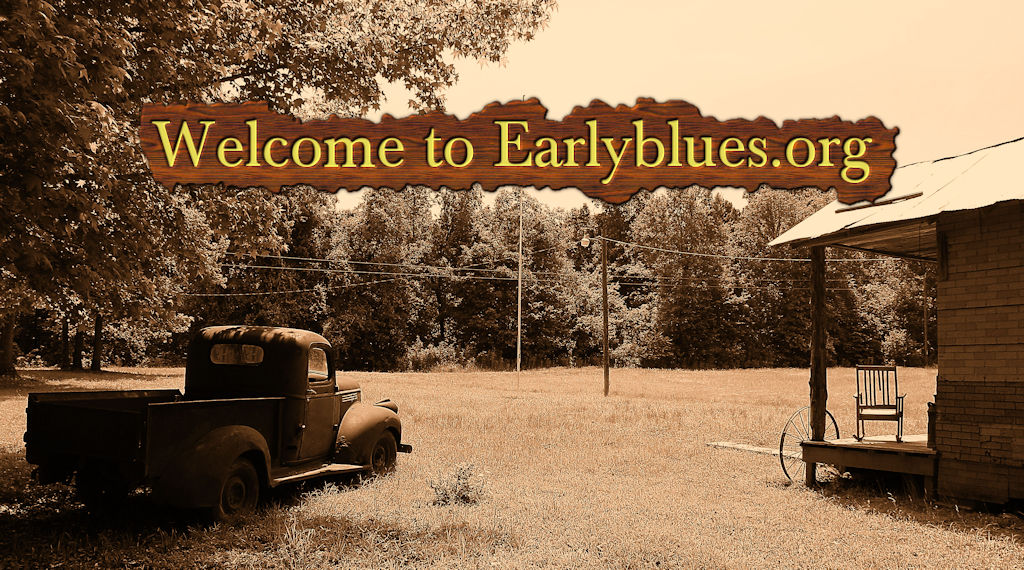Recommended British Blues History Books
Here is a bibliography of blues books concerning the history of British Blues.

|
‘Blowing The Blues: A Personal History of British Blues’ by Dick Heckstall-Smith and Pete Grant
Dick – the king of British blues saxophone – describes the revolutionary founding years of British R&B with wonderful anecdotes about Ginger Baker, Alexis Korner, Charlie Watts and the unforgettable Graham Bond.
Publishers: Clear Press (2004)
ISBN: 978-1904555049
|
 |
‘Blues In Britain’ by Bob Brunning (ex Fleetwood Mac / Savoy Brown)
The history of blues and R n’B in Britain from the tentative days on the 1950s to the thriving scene of the 1990s.
Publishers: Blandford (1995)
ISBN: 0-7137-2457-9
|
 |
‘The Blues Revival’ by Bob Groom (Studio Vista Series Edited by Paul Oliver)
Bob Groom surveys the expanding popularity of the blues, from skiffle through rock n’ roll to the current interest in both old-time and modern forms, describing research, rediscoveries and recordings.
Publishers: Studio Vista (1971)
ISBN: 289-701-48-1
|
 |
‘Blues: The British Connection’ by Bob Brunning (ex Fleetwood Mac / Savoy Brown)
Brunning’s book charts how London blues shows by US Bluesmen like Muddy Waters and Johnny Lee Hooker – then all but forgotten in their homeland – influenced a whole generation of British musicians from The Stones and The Animals to The Bluesbreakers and The Yardbirds.
Publishers: Blandford (1986)
ISBN: 978-0713718362
|
 |
‘John Mayall : The Blues Crusader’ by Dinu Logos
John Mayall is an icon in the world of blues music and the Godfather of British blues. A pioneering musician, blues promoter and talent scout for over 50 years, his uncanny knack of picking young, talented musicians and then nurturing them in his bands is the stuff of legend. Under his guidance as leader and sometimes father figure, his groups developed into a blues school of learning par excellence.
Publishers: Edition Olms (2015)
ISBN: 978-3283012281
|
 |
‘Alexis Korner: The Biography’ by Harry Shapiro
By the time Alexis Korner died in 1984 he had secured himself a place in history. Dubbed “the father of British blues”, he had become a mentor to generations of musicians. Out of Blues Incorporated, Korner’s original band, came bands, such as the Rolling Stones, Cream, the Animals, Free and Led Zeppelin. This biography recounts Korner’s early life travelling around Europe and North Africa; his settling in wartime London, discovering jazz and blues from Soho record shops; his membership of Chris Barber’s jazz band; his role in the development of skiffle; his founding, with Cyril Davies, of the Blues and Barrelhouse Club and of Blues Incorporated; his inspirational effect on younger musicians; and his immensely successful radio show, “Blues is Where You Hear It”, which ran for 20 years. The book includes a comprehensive discography of Alexis Korner’s numerous recordings.
Publisher: Bloomsbury Publishing PLC (1997)
ISBN: 9780747531630
|
 |
‘First Time We Met The Blues: A Journey of Discovery with Jimmy Page, Brian Jones, Mick Jagger and Keith Richards’ by David Williams
David Williams grew up in Epsom, Surrey and was a childhood friend of future Led Zeppelin guitar legend, Jimmy Page. Together they discovered what was for them an intriguing and very different kind of music: the blues. As their interest grew into a passion, they befriended other teenage enthusiasts – among them Brian Jones, Mick Jagger and Keith Richards – becoming part of a movement that ultimately brought about the ’60s rock revolution. Part-biography, part-history, “The First Time We Met The Blues” is packed full of great anecdotes and unique insights into the early British blues scene, Page’s formative years as a musician, the beginnings of the Rolling Stones, and much more besides.
Publishers: Music Mentor Books (2009)
ISBN: 978-0954706814
|
 |
‘Hoggin’ The Page – Groundhogs: The Classic Years’ by Martyn Hanson
The story of The Groundhogs spans the most exciting British rock will ever enjoy. Springing from the same early 1960s roots as the Animals, Pretty Things and Rolling Stones, they first made a reputation as a blues band backing the likes of John Lee Hooker on his tours of England.
Publishers: Northdown Publishing (2005)
ISBN: 1-900711-16-8
|
 |
‘It Ain’t Easy: Long John Baldry and the Birth of the British Blues’ by Paul Myers
Drawing on intimate anecdotes from Baldry’s legendary friends, lovers, and peers, author Paul Myers uncovers the man behind the mythic persona. An entire generation of British rock legends flourished under Baldry’s tutelage, and It Ain’t Easy features exclusive personal recollections.
Publishers: Greystone Books (2007)
ISBN: 978-1553652007
|
 |
‘Mothers (1968 – 1971) The Home of Good Sounds’ by Kevin Duffy (Forward by John Peel)
From 1968 – 1971 Mothers Club, Birmingham carved a niche in the history of rock music , being voted number one venue in the world by America’s Billboard Magazine. This book captures the spirit of the club, telling the story of its rise to fame as the mecca of the ‘underground’ music scene.
Publishers: Birmingham Library Services (1997)
ISBN: 0-7093-0217-7
|
 |
‘Strange Brew: Eric Clapton and the British Blues Boom 1965-1970’ by Christopher Hjort (Forward by John Mayall)
This is the day-by-day story of the 60s British blues boom, centering on key guitarists Eric Clapton, Peter Green, and Mick Taylor and the groups that they played in from 1965 to 1970 – John’s Mayall’s Blues breakers, Cream, Fleetwood Mac, Blind Faith, The Rolling Stones, Delaney & Bonnie, and more.
Publishers: Jawbone (2007)
ISBN: 978-1906002008
|
 |
‘White Bicycles: Making Music in the 1960s’ by Joe Boyd
When Muddy Waters came to London at the start of the 60s, a kid from Boston called Joe Boyd was his tour manager; when Dylan went electric at the Newport Festival, Joe Boyd was plugging in his guitar; when the summer of love got going, Joe Boyd was running the coolest club in London, the UFO. More than any previous 60s music autobiography, Joe Boyd’s White Bicycles offers the real story of what it was like to be there at the time.
Publishers: Serpent’s Tail (2007)
ISBN: 978-1852424893
|
 |
‘Sounds of the South’ edited by Daniel W. Patterson
The book of a 1989 conference that gathered record collectors, folklorists, musicians, record producers, librarians, archivists, and traditional music lovers—celebrated the official opening of the Southern Folklife Collection with the John Edwards Memorial Collection at the library of the University of North Carolina, Chapel Hill. Based on that conference, Sounds of the South includes Bill Malone’s account of his own career as fan and scholar of country music, Paul Oliver on European blues scholarship (including the emergence of British Blues), and Ray Funk on researching Black Gospel Quartets.
Publishers: Duke University Press
ISBN: 0-8223-1343-X
|
 |
‘Blues, How Do You Do? – Paul Oliver and the Transatlantic Story of the Blues’ by Christian O’Connell
Recent revisionist scholarship has argued that representations by white “outsider” observers of black American music have distorted historical truths about how the blues came to be. While these scholarly arguments have generated an interesting debate concerning how the music has been framed and disseminated, they have so far only told an American story, failing to acknowledge that in the post-war era the blues had spread far beyond the borders of the United States. As Christian O’Connell shows in Blues, How Do You Do? Paul Oliver’s largely neglected scholarship—and the unique transatlantic cultural context it provides—is vital to understanding the blues.
O’Connell’s study begins with Oliver’s scholarship in his early days in London as a writer for the British jazz press and goes on to examine Oliver’s encounters with visiting blues musicians, his State Department–supported field trip to the US in 1960, and the resulting photographs and oral history he produced, including his epic “blues narrative,” The Story of the Blues (1969). Blues, How Do You Do? thus aims to move away from debates that have been confined within the limits of national borders—or relied on clichés of British bands popularizing American music in America—to explore how Oliver’s work demonstrates that the blues became a reified ideal, constructed in opposition to the forces of modernity.
Publisher: University of Michigan Press ISBN: 978-0-0472-05167-7
|
 |
‘How Britain Got the Blues: The Transmission and Reception of American Blues Style in the United Kingdom’ by Roberta Freund Schwartz
This book explores how, and why, the blues became a central component of English popular music in the 1960s. It is commonly known that many ‘British invasion’ rock bands were heavily influenced by Chicago and Delta blues styles. But how, exactly, did Britain get the blues? Blues records by African American artists were released in the United States in substantial numbers between 1920 and the late 1930s, but were sold primarily to black consumers in large urban centres and the rural south. How, then, in an era before globalization, when multinational record releases were rare, did English teenagers in the early 1960s encounter the music of Robert Johnson, Blind Boy Fuller, Memphis Minnie, and Barbecue Bob? Roberta Schwartz analyses the transmission of blues records to England, from the first recordings to hit English shores to the end of the sixties.
Publisher: Routledge (2016)
ISBN: 0754655806
|
 |
‘Cross The Water Blues’ edited by Neil A. Wynn
This unique collection of essays examines the flow of African American music and musicians across the Atlantic to Europe from the time of slavery to the twentieth century. In a sweeping examination of different musical forms–spirituals, blues, jazz, skiffle, and orchestral music–the contributors consider the reception and influence of black music on a number of different European audiences, particularly in Britain, but also France, Germany, and the Netherlands. The essayists approach the subject through diverse historical, musicological, and philosophical perspectives. A number of essays document little-known performances and recordings of African American musicians in Europe. Several pieces, including one by Paul Oliver, focus on the appeal of the blues to British listeners.
Publisher: University Press of Mississippi (2007)
ISBN: 1578069602
|
 |
‘British Blues on Record, 1957-1970: A Selected Discography’ by Leslie Fancourt
Published by Retrack Books (1992)
ISBN: 9781874354017
|
 |
‘The British Blues Network: Adoption, Emulation and Creativity’ by Andrew Kellett
Published by University of Michigan Press
ISBN: 978-0-472-03699-8
This book is about the blues and its impact in Great Britain, and it is also about the rock music made in the 1960s and 1970s by young, mostly male British musicians who were inspired by the blues. It is, at heart, a way of making sense of two distinct yet related historical statements about that music. The first is cultural historian David Christopher’s assertion that “by the mid-1970s all the major [rock] bands in the world were British.” The second is music critic and historian Robert Shelton’s argument that “musical developments” made by British groups such as Eric Clapton, the Rolling Stones, and Led Zeppelin were “more imaginative” than those made by their American counterparts.
|
 |
‘AS YOU WERE: The true adventures of the Ricky-Tick club’ by John Mansfield and Colin Mansfield
Self published.
With no particular idea where they were heading, but determined to have fun on the way, following ‘demob’ after their National Service in Germany, John Mansfield and Philip Hayward spent the next three years running a Trad Jazz club in Windsor. As the social hub for the young, once a week it neatly combined all their interests under one roof- au pairs, booze and Jazz. However, they were caught up in a constant struggle to make ends meet and had to live on their wits and their wit to support their partying lifestyle. All that changed when John decided to open the first R&B club outside of London. On December 14th, 1962 The Rolling Stones played their first ever gig with Bill Wyman at this club. The floodgates opened. Philip hopped on board, and within eighteen months the Stones had played over forty times for them….and that was just the beginning. Over the next four years, as one of the UK’s top R&B promoters, virtually every worthwhile British R&B group, including The Animals, The Who, Cream and The Yardbirds, as well as many visiting US stars like Jimi Hendrix, Stevie Wonder, John Lee Hooker and Sonny Boy Williamson, played for them in over twenty-seven different towns across southern England.
|
 |
‘Life After Dark: A History of British Nightclubs & Music Venues’ by Dave Haslam
Published by Simon & Schuster UK
Nightclubs and music venues are often the source of a lifetime’s music taste, best friends and vivid memories. They can define a town, a city or a generation, and breed scenes and bands that change music history. In Life After Dark Dave Haslam reveals and celebrates a definitive history of significant venues and great nights out. Writing with passion and authority, he takes us from vice-ridden Victorian dance halls to acid house and beyond; through the jazz decades of luxurious ballrooms to mods in basement dives and the venues that nurtured the Beatles, the Stones, Northern Soul and the Sex Pistols; from psychedelic light shows to high street discos; from the Roxy to the Hacienda; from the Krays to the Slits; and from reggae sound systems to rave nights in Stoke.
|
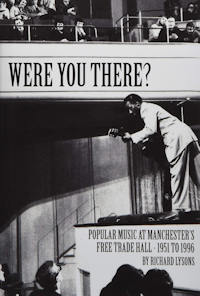 |
‘Were You There?: Popular Music at Manchester’s Free Trade Hall – 1951 to 1996’ by Richard Lysons
Published by Empire Publications (UK)
Manchester’s Free Trade Hall was arguably the most important popular music venue in Great Britain between 1951 and 1996. After several incarnations, the building was re-constructed in the wake of the Manchester Blitz and opened in 1951 as the new home of the city’s esteemed Hallé Orchestra. Yet it was popular music which would secure the venue its fame as it responded to each wave of popular music from jazz and skiffle, through rock ‘n’ roll and folk to prog, punk and heavy metal. From Billie Holiday to Blondie, Duke Ellington to Led Zeppelin, Pink Floyd to Happy Mondays, Rolling Stones to The Beach Boys, David Bowie to Suede, just about everyone who mattered played there. The Free Trade Hall was also the venue for incendiary gigs by Bob Dylan in 1966 and the Sex Pistols a decade later which changed the course of music history. Richard Lysons’ “meticulously researched tome” will be of interest to anyone who ever attended a concert at the venue or has an interest in the history of popular music in Britain’s most musically important city. Alongside his own expert commentary on every headline act he gives the reader a sense of what was going on at other venues in Manchester. There are photographs of several seminal blues gigs by Brian Smith who attended concerts at the Free Trade Hall throughout the 1960s.
|
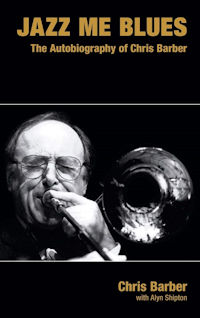 |
Jazz Me Blues – The Autobiography of Chris Barber by Chris Barber and Alyn Simpson
Published by Equinox Publishing
Jazz trombonist Chris Barber formed his first band in the late 1940s, but it is the band that he has led from 1954, after parting company with trumpeter Ken Colyer, that has established all kinds of records for success and longevity. The 54 year partnership with trumpeter Pat Halcox is the longest continuous association in jazz history. The Barber band achieved chart success on both sides of the Atlantic, with “Petite Fleur”, and from the middle to late 1950s it was the most popular music act in the UK. The band was one of the first British jazz groups to tour extensively in the United States. It has remained one of the most popular and widely imitated jazz bands in Europe for over half a century. In this candid account of his life and music, Barber tells the story of his band, but also of his many other contributions to music in Britain. He and his guitarist and singer Lonnie Donegan began the skiffle movement. His band pioneered touring with authentic American blues and gospel musicians, including Big Bill Broonzy, Sister Rosetta Tharpe, Muddy Waters, Sonny Terry and Brownie McGhee. There were also tours with American jazz soloists, including John Lewis, Trummy Young, Ray Nance and many others. Barber and his colleague Harold Pendleton also launched the Marquee Club in London, which became a legendary jazz and rock venue, as well as becoming the launchpad for the Richmond and Reading Festivals. Barber’s band has always been devoted to both jazz and blues, touring for many years with the charismatic Northern Irish singer Ottilie Patterson, (who became Barber’s wife) and also including the blues guitarist John Slaughter in the line-up. In 2001 the band became the Big Chris Barber Band, allowing him to continue to play the New Orleans jazz he has always loved, but also to play the big band repertoire of musicians such as Duke Ellington.
|
 |
Published by Robin Bell (Kindle)
|
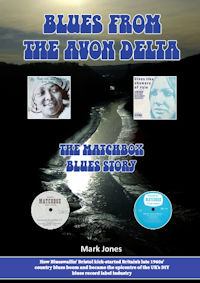 |
Blues From The Avon Delta: The Matchbox Blues Story by Mark Jones
How Blueswailin’ Bristol kick-started Britain’s late 1960s’ country blues boom and became the epicentre of the UK’s DIY blues record label industry
ISBN: 978-1-909953-76-5
Publisher: The Record Press (an imprint of Bristol Folk Publications)
Available from :
https://sites.google.com/site/bristolfolk/musicdiscographies
|
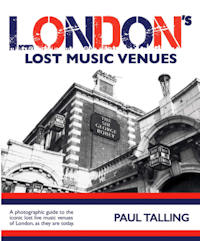 |
London’s Lost Music Venues
A photographic guide to the iconic lost live music venues of London, as they are today. Paul Talling takes a look at some of London’s much missed music venues from the post-war period to the present day. Featuring photos, adverts & tickets, this book is a portal to a less homogenised London, taking you back to the city’s halcyon days of jazz, blues, folk, rock, punk, indie and more. Paul Talling, author of Derelict London and London’s Lost Rivers (Random House) turns his attention to the lost and derelict music venues of London, focusing on the smaller, club-sized venues. This book takes a look at some of the iconic venues of the last 60 years with images, flyers and modern day photos of what they are now. Venues include The Marquee Club, The Vortex, The Roxy, The Falcon, The Bull & Gate and many more.
Publisher: Damaged Goods Books
ISBN: 978-1916232709
|



